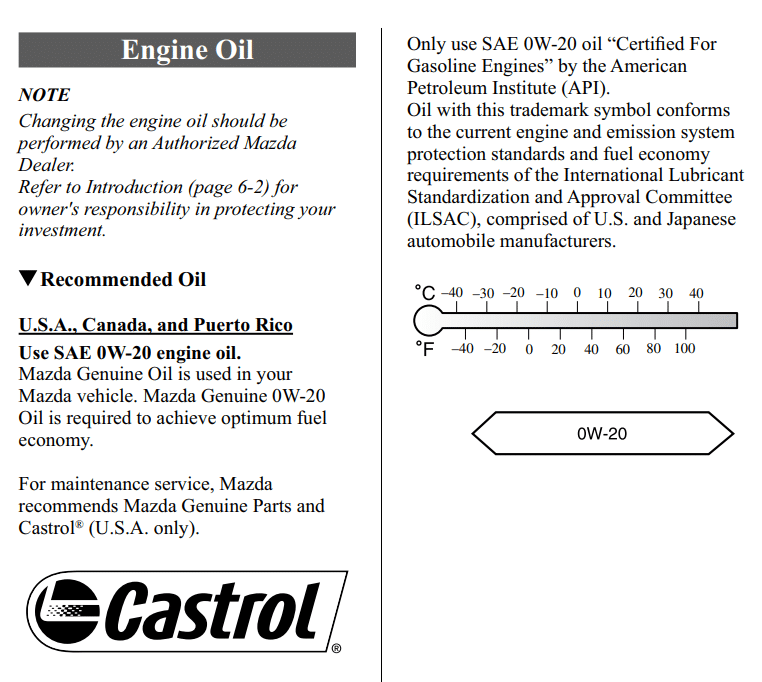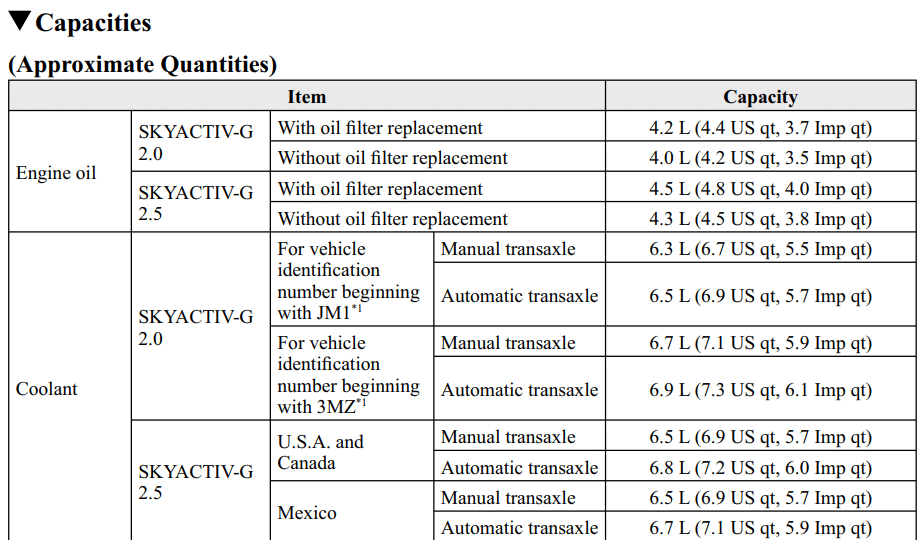The Mazda 3 has always been lauded as a vehicle that artfully balances performance, economy, and reliability. The 2015 model year carries on this tradition with two engine choices: the responsive SKYACTIV-G 2.0 and the more powerful SKYACTIV-G 2.5. These engines’ designs are underpinned by the principles of maximizing efficiency and reducing harmful environmental emissions. But to continue performing at their peak, these engines require the right maintenance and attention, with the selection of engine oil playing a critical role.
Oil is the lifeblood of your Mazda 3’s engine. It serves to lubricate moving parts, reduce friction, cool engine components, and help keep the engine clean by reducing deposits. The right oil helps ensure smooth operation, extends engine life, and even contributes to fuel efficiency. However, not all engine oils are created equal. Using the wrong type of oil can adversely affect the engine’s performance and even cause damage over time.
In the 2015 Mazda 3, the manufacturer specifically recommends SAE 0W-20 oil. This oil type, especially if it’s Mazda Genuine Oil, is designed to work optimally with your vehicle’s engine, protecting its components, improving your mileage, and providing the level of performance you’ve come to expect from Mazda. Choosing the right engine oil is therefore crucial to the health, longevity, and performance of your Mazda 3.

What Kind Of Oil Does A 2015 Mazda 3 Take?
The manufacturer’s recommendation for the 2015 Mazda 3, regardless of whether you have the SKYACTIV-G 2.0 or SKYACTIV-G 2.5 engine, is SAE 0W-20. This grade of oil is a low-viscosity full-synthetic oil.
The ‘0W’ refers to how the oil flows at cold temperatures (the ‘W’ stands for ‘winter’), and ’20’ indicates the oil’s viscosity at higher operating temperatures. The lower the numbers, the thinner the oil, meaning it flows more easily. This grade of oil is designed to provide excellent protection, reduce engine wear, and improve fuel efficiency, especially in colder conditions when engines are most vulnerable.
Mazda Genuine Oil is specially formulated to offer optimal performance for your Mazda vehicle. This oil is fully synthetic, meaning it provides superior engine protection compared to conventional oil, especially under extreme temperatures. It also keeps your engine cleaner and helps improve fuel economy, making it an excellent choice for maintaining your Mazda 3.
When choosing an oil, it’s not enough to simply match the manufacturer’s recommended viscosity grade. It’s also vital to ensure the oil meets certain industry standards. Two important certifications for engine oils are from the American Petroleum Institute (API) and the International Lubricant Standardization and Approval Committee (ILSAC).
API-certified oils have passed a variety of tests to meet specific engine and emission system protection standards. These oils bear the API “donut” symbol on their packaging.
ILSAC, on the other hand, is a joint effort of U.S. and Japanese auto manufacturers to set minimum performance standards for lubricants. ILSAC-certified oils not only meet engine protection requirements but also fuel economy standards. Oils meeting ILSAC requirements bear a round “starburst” certification symbol.

For your 2015 Mazda 3, it’s recommended to use SAE 0W-20 oil that is “Certified For Gasoline Engines” by API and meets ILSAC’s fuel economy requirements, ensuring your engine is well-protected, performs optimally, and runs as efficiently as possible.
Understanding the Basics
Engine oil plays several critical roles in maintaining your vehicle’s performance and longevity. At its core, it is a lubricant. It creates a thin layer between metal surfaces in your engine, reducing friction, which in turn minimizes wear and tear and prevents overheating.
The oil also acts as a coolant. While your car has a separate cooling system, it doesn’t reach all the engine’s parts. The oil helps by carrying away some of the heat generated in areas like the piston assembly, thereby preventing engine overheating.
Additionally, engine oil assists in keeping the engine clean. It washes away dirt and small particles, preventing deposits from forming within the engine. Modern oils contain additives, including detergents, that help remove these deposits.
Lastly, the oil serves as a barrier that prevents corrosion inside the engine. Certain additives within the oil neutralize harmful acids that form due to fuel combustion, thereby preventing rusting and corrosion of internal components.
Importance of Using the Right Oil Type for Your Car’s Engine
The type of oil you use in your engine can significantly affect its performance, efficiency, and service life. Each vehicle manufacturer specifies a certain type of oil – often a specific viscosity – to use in their engines. This recommendation is based on various factors, including the engine’s operating temperatures, the typical speed at which the engine parts move, and the specific design of the engine components.
Using the wrong type of oil can lead to problems. For example, oil that’s too thin may not adequately lubricate the engine, leading to increased wear. The oil that’s too thick might not flow smoothly to all engine parts, particularly when the engine is cold, again leading to increased wear and potential damage.
For your 2015 Mazda 3, whether equipped with the SKYACTIV-G 2.0 or 2.5 engine, the recommended oil is SAE 0W-20. By adhering to this specification, you ensure that your engine is properly protected, operates as efficiently as possible, and is likely to provide long, reliable service.
Comparing Different Types of Oil
There are several types of engine oil available on the market, each with its own benefits and intended uses.
- Conventional Oil: This is the traditional oil used in many older vehicles. It is derived directly from crude oil and provides adequate lubrication under a range of conditions.
- Synthetic Oil: This type of oil is engineered in a laboratory and offers several benefits over conventional oil. It performs better at extreme temperatures, offers improved lubrication, and lasts longer.
- Synthetic Blend: This is a mix of conventional and synthetic oil, offering some of the benefits of synthetic oil but at a lower cost.
- High-Mileage Oil: Designed for vehicles with high mileage (typically over 75,000 miles), this type of oil contains additives that help protect and rejuvenate seals and gaskets in the engine, reduce oil consumption, and reduce leaks.
For your 2015 Mazda 3, the manufacturer specifically recommends synthetic oil, specifically SAE 0W-20. Here’s why:
- Conventional Oil: While less expensive, conventional oil doesn’t offer the same level of protection, especially under extreme temperatures, and doesn’t last as long between oil changes. It’s not recommended for the 2015 Mazda 3.
- Synthetic Oil: This is the recommended oil for your vehicle. It offers superior performance, better protection for your engine, improves fuel efficiency, and lasts longer between oil changes.
- Synthetic Blend: This could be a more affordable option for some drivers. However, it does not offer the full benefits of full synthetic oil.
- High-Mileage Oil: If your Mazda 3 has racked up a high number of miles, you might consider high-mileage oil. But consult your mechanic first because it’s essential to balance the high-mileage additives with the manufacturer’s recommendation of synthetic oil.
Viscosity refers to the oil’s resistance to flow. In engine oils, it’s usually given as a two-part number (e.g., 0W-20). The first number (with the “W” for winter) indicates the oil’s viscosity when cold, while the second number refers to its viscosity when hot.
Viscosity is crucial because the oil must be thin enough to flow easily when the engine is cold (at startup), but thick enough to provide adequate lubrication when the engine is hot. The recommended 0W-20 oil for the 2015 Mazda 3 provides excellent flow in cold starts and remains strong under normal operating temperatures, offering optimal protection for your engine.
How Much Oil Does A Mazda 3 2015 Take?
Knowing the exact oil capacity of your vehicle’s engine is crucial to prevent over or underfilling during oil changes. Both can lead to problems: overfilling can cause oil foaming, decreased lubrication, and pressure buildup that can lead to leaks while underfilling won’t adequately lubricate your engine, increasing wear and the potential for overheating.
Engine Oil Capacity for SKYACTIV-G 2.0
The SKYACTIV-G 2.0 engine equipped in some models of the 2015 Mazda 3 has an oil capacity of 4.2 liters (4.4 US quarts, 3.7 Imperial quarts) when you’re also replacing the oil filter. Make sure always to check the oil level using the dipstick after filling and running the engine briefly to ensure you’ve added the proper amount.
Engine Oil Capacity for SKYACTIV-G 2.5
On the other hand, the larger SKYACTIV-G 2.5 engine found in other versions of the 2015 Mazda 3 requires a bit more oil due to its larger size. Its capacity is 4.5 liters (4.8 US quarts, 4.0 Imperial quarts) with a filter change. Again, always double-check the level with the dipstick after adding oil and running the engine for a few moments. It’s also a good idea to check the oil level again after driving a few miles.

By knowing the specific oil capacities of these two engines, you can ensure that your 2015 Mazda 3 is always filled with the appropriate volume of oil, ensuring optimal engine lubrication and performance.
Frequency of Oil Changes
The recommended oil change interval for the 2015 Mazda 3 is every 7,500 miles or six months, whichever comes first, under normal driving conditions. This interval ensures that your engine oil is always fresh and capable of providing the necessary lubrication, cleaning, and cooling functions to keep your engine running smoothly.
While the recommended oil change interval provides a good guideline, actual oil change frequency can be influenced by several factors.
- Driving Habits: If you often drive short distances, particularly in stop-and-go traffic, or frequently tow heavy loads, you might need more frequent oil changes. These conditions put more stress on the engine and can cause oil to degrade faster.
- Climate: If you live in an area with extreme temperatures, whether hot or cold, your engine oil might be subjected to harsher conditions that degrade it faster.
- Type of Oil: As mentioned earlier, synthetic oil tends to last longer than conventional oil. If you’re using synthetic oil (as recommended), you’ll be able to follow the longer recommended oil change interval.
Remember, the oil change interval should never be exceeded, but you might need to change the oil more frequently based on these factors. Always consult your owner’s manual or a trusted mechanic if you’re unsure. Regular oil changes are one of the easiest and most effective ways to ensure the longevity and optimal performance of your vehicle.
References
- 2015 Mazda3 Owner’s Manual. Mazda Motor Corporation. This is the primary source of specific information about the 2015 Mazda 3.
- American Petroleum Institute (API): The API website provides details about oil standards and certifications: (https://www.api.org/).
Last update on 2026-01-21 / Affiliate links / Images from Amazon Product Advertising API




